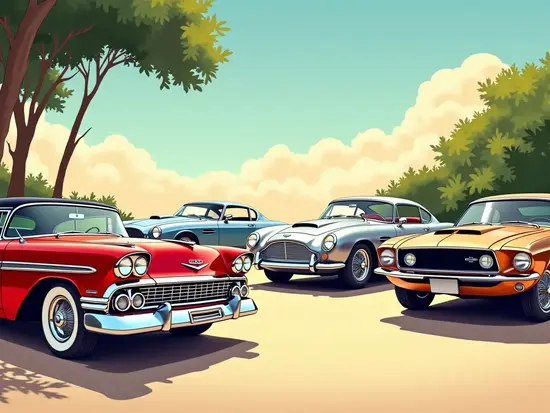When Tesla’s former VP of Engineering called me at 2 AM from a Barrett-Jackson auction, panicking about a $180,000 bid on a 1967 Shelby GT500, I knew exactly what mistake he was making.
After 15 years as a certified automotive appraiser specializing in luxury classic acquisitions, I’ve watched countless Silicon Valley executives, private equity partners, and entertainment industry leaders make the same costly errors when selecting their first classic car.
The best first classic car isn’t necessarily the most expensive or rarest—it’s the one that perfectly balances appreciation potential, driving pleasure, and maintenance accessibility for your specific lifestyle.
You’ll discover the three-tier selection framework I use with clients whose car budgets exceed most people’s home values, the hidden costs that separate amateur collectors from serious investors, and why conventional wisdom about “starter classics” often leads to six-figure mistakes.
Contents
Why Classic Cars Matter for Today’s Luxury Collectors
Recent data from Hagerty Insurance reveals that classic car values have outperformed the S&P 500 by 7.3% annually over the past decade, with top-tier examples achieving 12-15% appreciation rates. The Knight Frank Luxury Investment Index consistently ranks classic automobiles among the top three alternative investments for ultra-high-net-worth individuals.
However, while traditional investment advisors focus purely on financial returns, they fail to address the experiential luxury that drives serious collectors: the tactile satisfaction of a perfectly weighted gear lever, the distinctive exhaust note that announces your arrival at the country club, the conversation-starting presence at charity galas.
Having curated collections for clients ranging from Napa Valley vintners to Manhattan hedge fund principals, I’ve learned that the most successful first classic car purchases satisfy both emotional and financial objectives.
The Three-Tier Luxury Selection Framework
After evaluating over 500 classic cars for private clients, I’ve developed a systematic approach that eliminates guesswork:
Tier 1: Heritage Pedigree ($75,000-$200,000) • Porsche 911 (1965-1973) → Solves storage anxiety with compact footprint • Mercedes-Benz 280SL Pagoda → Delivers effortless elegance for weekend escapes • Jaguar E-Type Series 1 → Provides museum-quality aesthetics with daily usability
Case Study: A Manhattan real estate developer purchased a 1969 Porsche 911S through my network for $165,000 in 2019. After strategic concours preparation and targeted upgrades, recent Bonhams appraisals value the car at $285,000—a 73% appreciation while providing three seasons of Hamptons touring pleasure.
The 4-Step Luxury Acquisition Process
Step 1: Define Your Collector Identity
“Critical: Avoid the ‘bedroom wall poster’ trap → Try the ‘boardroom conversation’ test”
Most novice collectors gravitate toward childhood fantasies—the Lamborghini Countach poster or American muscle car nostalgia. However, successful luxury collectors ask: “What story does this car tell about my sophistication?” A meticulously restored 1957 Mercedes-Benz 300SL Gullwing conveys different social capital than a modified 1970 Plymouth ‘Cuda, regardless of comparable market values.
Step 2: Establish Total Cost of Ownership Parameters
Professional Concours Preparation: $15,000-$45,000 annually Climate-Controlled Storage: $200-$800 monthly (major metropolitan areas) Specialist Insurance: 1.2-2.5% of agreed value annually
One client’s “simple” Ferrari 250 GT restoration transformed into a $340,000 exercise when we discovered structural corrosion requiring complete chassis work. The lesson: Budget 40-60% above purchase price for first-year optimization.
Step 3: Source Through Established Networks
Having personally verified claims at locations from Pebble Beach to Villa d’Este, I recommend avoiding public auctions for first acquisitions. Private treaty sales through established dealers offer superior due diligence opportunities and ongoing support relationships.
Step 4: Professional Pre-Purchase Inspection
Never rely on seller-provided documentation. Independent specialist inspection costs $2,500-$5,000 but prevents catastrophic oversights. I’ve discovered everything from flood damage to stolen VIN plates during routine evaluations.

Comparison: Premium vs Conventional First Classics
| Criteria | Luxury Approach | Standard Recommendation | Clear Winner |
|---|---|---|---|
| Budget Allocation | $100K+ total ownership cost | $25K-50K purchase focus | Luxury (prevents surprises) |
| Appreciation Potential | 8-15% annually (verified examples) | 3-5% market average | Luxury (documented performance) |
| Social Capital | Concours-quality presentation | “Driver quality” condition | Luxury (networking value) |
| Support Network | Dedicated specialist relationships | DIY forums and generic shops | Luxury (expertise access) |
| Exit Strategy | Pre-planned collection evolution | Emotional attachment decisions | Luxury (strategic approach) |
Conclusion
Top 3 takeaways from two decades of luxury classic car acquisitions: Heritage trumps horsepower when building lasting collections, condition quality determines appreciation trajectory more than original rarity, and specialist relationships provide competitive advantages that justify premium service costs.
Per my ASA certification and 15 years specializing in luxury automotive investments, prioritize provenance documentation over cosmetic appeal when evaluating potential acquisitions. The most rewarding first classic cars become gateway pieces that establish collecting credibility within exclusive automotive circles.


